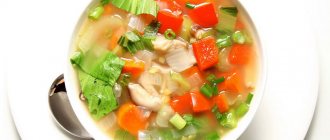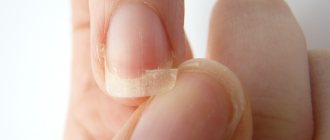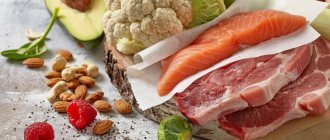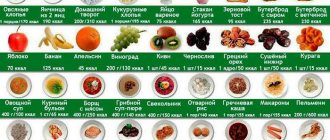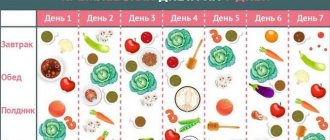What is the essence of the weight loss method?
Carbohydrates provide the body with the necessary amount of energy, which is spent during the day on vital processes and during physical activity. A complete refusal of a macronutrient will lead to malfunctions in the functioning of functional systems, and a surplus of energy received will lead to an increase in fat reserves. A low-carbohydrate diet includes slow (complex) carbohydrates, which do not cause a strong spike in blood sugar and take longer to convert into energy.
The essence of the method is that from the first day of the diet for safe and effective weight loss, every day the amount of carbohydrates consumed is reduced, and proteins increase. Thanks to this, the following processes are launched in the body:
- Previously received energy is in short supply, which forces us to look for a new source.
- In the first 2-3 days of the diet, glycogen becomes the main supplier of energy.
- Next, fats are broken down, synthesizing an additional source of energy - ketone.
Studies comparing the benefits of low-carb and low-fat diets for weight loss found that people who minimized carbohydrates lost more weight over 6 months than those who followed a low-fat diet.
With a low-carbohydrate diet, subjects felt fuller after eating because proteins and fats break down more slowly than carbohydrates. In addition, the increase in blood sugar levels and insulin production occurred gradually. This means that they did not have sudden bursts of energy, which are replaced by fatigue and an increased feeling of hunger.
Conclusion : the principle of the diet is biochemical processes that promote fat burning and loss of extra pounds.
It is important to remember that during a diet, the fat layer is uniformly reduced throughout the body, so it is impossible to reduce volumes locally.
Advantages and disadvantages
The low carbohydrate content in the menu has a beneficial effect on the body's condition, normalizing digestion, increasing metabolic processes and rejuvenating.
Pros:
- on a diet there is no hunger, strength remains at the same level, there is no weakness;
- suitable for diabetics;
- suitable nutrition for men and women for the purpose of losing weight;
- Suitable for low, medium and high activity levels;
- does not require a significant change in the calculation of daily calorie needs when losing weight, the indicators of proteins and carbohydrates change.
Reducing the amount of macronutrients helps to lose weight and improve health, recommended for:
- overweight;
- intense training;
- diabetes mellitus;
- hypertension;
- endocrine system disorders;
- oncological diseases.
The method has gained confidence among athletes and competitive bodybuilders - it is a reliable opportunity to gain relief by reducing the percentage of subcutaneous fat and maintaining muscle mass.
However, the diet has disadvantages:
- constipation - a decrease in fiber, which is associated with a reduction in carbohydrate intake, can lead to digestive problems;
- carbohydrate starvation can cause headaches, irritability and nervousness;
- exacerbation of chronic diseases;
- increases the load on the liver;
- potassium and sodium are in short supply;
- carbohydrate deficiency reduces concentration, which is critical for people engaged in mental work;
- an increase in cholesterol levels due to a large amount of animal products, which provokes the development of diseases of the cardiovascular system;
A low-carb diet is not on the list of methods that can be followed for several years, since a large list of prohibited foods creates additional stress for the body. Therefore, after several weeks or months of restrictions, a person returns to his usual diet.
Balance of proteins, fats, carbohydrates
The main source of protein on a low-carb diet is animal products: meat, poultry, offal, cottage cheese, eggs. For vegetarians, legumes and nuts are an alternative.
The ratio of BJU in the diet is within:
- Proteins 40-50%;
- Fats 30-35%;
- Carbohydrates 20-25%.
General rules
In recent years, fat-protein diets with extremely low carbohydrate content have become very popular.
Let's consider the question of what a low-carbohydrate diet is, its features and purpose. Dietary systems with carbohydrate restriction are used for various purposes: for weight loss, for diabetes mellitus , for the treatment of obesity , for hypertension . Low-carbohydrate diets (the so-called keto diets ) are also indicated for athletes involved in a sport such as billballing, which uses a special nutrition system - drying, which allows you to quickly gain relief and expressiveness of the body by reducing the fat layer and increasing lean muscle mass. And each of the intended purposes of diets with a reduced carbohydrate component has its own rules and many nuances.
Carbohydrates are a large class of chemical compounds, including simple (monosaccharides) and complex (polysaccharides) carbohydrates, each of which has different effects on metabolism:
- simple carbohydrates - are quickly absorbed in the body and are broken down into monosaccharides (glucose/fructose) during metabolism. They are quickly absorbed in the body and, if they are supplied in excess, and there is no need for them, they are converted into intra-abdominal and subcutaneous fat. When they are utilized, the blood sugar level quickly rises, which provides a feeling of satiety, which passes just as quickly. Products containing simple carbohydrates include sugar, sweet fruits, honey, jam, preserves, confectionery, candies and other sweets;
- complex carbohydrates (starch, glycogen , pectin , fiber, inulin ) are absorbed slowly in the body (the duration is 3-5 times longer). They have a complex structure and include many monosaccharides. They are broken down in the small intestine, and their absorption is slowed down by fiber. Complex carbohydrates increase blood sugar slowly, and therefore the body is saturated with energy evenly. Products containing complex carbohydrates (fiber, starch, pectin) include whole grain bread, white rice, cereals and cereals made from them, pasta, bananas, pineapple, dried fruits.
In essence, a low-carbohydrate diet models metabolic processes in the body that are identical to fasting, when metabolism is reoriented to gluconeogenesis , in which the process of glucose formation occurs from non-carbohydrate components (glycerol, lactic/pyruvic acid, amino acids , fatty acids). In the initial period of fasting, the metabolism of amino acids (protein) increases, which reaches a certain level and persists for 25-30 days, and then the use of protein as “metabolic fuel” slows down sharply, since its reserves in the body can only decrease to a certain level. At the same time, the mobilization and oxidation of free fatty acids accelerates.
At this stage, under conditions of severe carbohydrate deficiency, energy metabolism switches from carbohydrate to lipid metabolism, in which the energy substrate is the oxidation of fatty acids with the production and accumulation of ketone bodies. Thus, a low-carbohydrate, high-fat diet induces benign ketosis. And mobilization from the glycogen and the relatively rapid development of a feeling of satiety contributes to a faster rate of body weight loss.
When using diets of this type, it should be taken into account that the low content of carbohydrates and dietary fiber in the diet causes insufficient intake of vitamins and minerals into the body. Therefore, diets that suppress appetite against the background of rapid ketosis, even with the additional introduction of necessary components into the diet, can be prescribed for a limited period. When following low-carbohydrate diets, it is important to remember that the mechanism of formation of ketosis bodies is triggered by limiting carbohydrates in the diet to 100 g/day.
Hypocarbohydrate diet for weight loss
It is based on a sharp restriction in the diet of the amount of foods containing predominantly simple carbohydrates and, to a lesser extent, foods high in complex carbohydrates. At the same time, the protein content in the diet corresponds to the physiological norm, and the fat consumption rate is moderately reduced. Accordingly, the total calorie content of the daily diet is reduced to 1700-1800 Kcal/day. Limiting carbohydrates in weight loss diets below 120-130 g is not recommended or acceptable when using fasting diets for a short period. The choice of products - sources of carbohydrates is determined by the required degree of reduction in the energy value of the daily diet, the duration of the diet and the specified goal.
In the diet, sugar and sugar-containing products, confectionery products, sweet drinks, honey, ice cream are excluded, bakery and pasta products made from premium flour, polished rice, semolina are limited, and in cases where it is necessary to further reduce the energy value of the diet (up to 1000- 1200 kcal/day) excludes other cereals, potatoes, some fruits and berries (grapes, bananas,) dried fruits. The main source of carbohydrates should be products containing vitamins and minerals, rich in dietary fiber - dietary types of bread with the addition of bran and crushed grains, ground or wholemeal bread, legumes, cereals, preferably whole grains or partially retaining the shell (unpolished rice, buckwheat, barley/oatmeal porridge), vegetables, non-sweet fruits and berries.
It is important to understand that an anti-carbohydrate diet with the exclusion/limitation of sugar and sugar-containing foods in the diet does not mean that sugar contributes more to weight gain/ obesity than other carbohydrates. The presence of sugar in the diet is not important for reducing body weight in cases where the energy value of the diet is less than energy expenditure. The point of choosing carbohydrate sources is that products containing complex carbohydrates have a higher nutritional value (create conditions for the natural activity of intestinal microflora, stimulate the motor function of the gastrointestinal tract, adsorb toxic compounds, cholesterol ) and allow for more stable and long-lasting satiety than sugar-containing ones. products.
Low-carbohydrate diet - table of foods with quantitative carbohydrate content
To create a low-carbohydrate diet, it is important to understand the quantitative content of carbohydrates in certain foods. This information is reflected in the table below.
| Product name | Carbohydrate content |
| Bagels | 58 |
| Boiled pasta | 25 |
| Wheat porridge | 27 |
| White sugar | 105 |
| Armenian lavash | 56 |
| White bread | 51 |
| Bread Borodinsky | 39 |
| Green peas | 12 |
| Milk chocolate | 62 |
| Boiled white rice | 30 |
| Marmalade | 70 |
| Honey | 77 |
| Buckwheat | 29 |
| Dates | 68 |
| Peanut | 15 |
| Shortbread cookies | 58 |
| Hazelnut | 15 |
| Sunflower seeds | 18 |
| Sesame seeds | 20 |
| Walnuts | 11 |
| Watermelon | 9 |
| Eggplant | 5 |
| Cornflakes | 75 |
| Parsley | 8 |
| Tomatoes | 4 |
| Sour cream | 3 |
| Sweet pepper | 5 |
| Boiled potatoes | 16 |
| Boiled beets | 7 |
| Fruit kefir | 5 |
| Whole milk | 12 |
| Banana | 22 |
| Milk ice cream | 25 |
| Cashew | 25 |
| Carrot | 5 |
| Grape | 15 |
| Raspberries, strawberries | 5 |
| Tangerines, oranges | 7 |
| Apricot compote | 23 |
| Pear compote | 15 |
| Apples | 10 |
| Red/black currant | 7 |
| Cherry | 12 |
| Dried rose hips | 26 |
The main principles of a low-carb diet are:
- Reducing the diet of carbohydrates (mostly simple) to 120-130 g/day with a physiological norm of protein content and moderate restriction of fats (up to 70-75 g/day), mainly due to the reduction of solid animal fats. The ratio of complex and simple carbohydrates should be approximately 95 to 5. At least 50% of the protein in the diet should be provided by animal products: eggs, lean fish, meat, cottage cheese, seafood. The calorie content of the daily diet should vary between about 1700-1800 Kcal/day.
- The main intake of complex carbohydrates should be in the first half of the day. At dinner, you should give preference to protein foods.
- Limiting the consumption of salt and salty foods.
- Meals are split, no snacks between meals.
- Prepare food using dietary culinary methods for processing foods - boil, steam, stew, bake. Frying food is not allowed.
- Drink at least 2 liters/day of free fluid.
To increase the effectiveness of a low-carbohydrate diet, it is recommended to practice fasting days, since they accelerate the mobilization of fat from the depot and contribute to the restructuring of metabolism.
However, it is necessary to understand that the energy value of fasting days varies at the level of 500-700 kcal/day and has a limited range of products, which leads to a deficiency of essential food nutrients . Therefore, fasting days can be used no more than 1-2 times a week. There are extremely many options for fasting days - mainly protein (meat, kefir, fish, cottage cheese), carbohydrate (fruit and vegetable), combined - relatively close in the composition of nutrients and products to a balanced diet.
Below are some options for fasting days:
- Kefir-curd diet - 50 g of low-fat cottage cheese and 200 ml of yogurt or 1% fat kefir, 5 times a day;
- Meat (fish) diet - 50-70 g of boiled lean meat (fish), 5 times a day and 100-150 g of vegetables (cucumbers, cabbage, tomatoes) 5 times a day.
Vegetable and fruit diets have a particularly low energy value (250-300 kcal), which can be recommended both for adult men and women with a regular diet, and for vegetarians.
- Salad diet - 250 g of raw fresh vegetables in the form of salads 5 times a day, if necessary, with the addition of 10 g per day of vegetable oil or 10% sour cream.
- Cucumber diet - 300 g of fresh cucumbers, 6 times a day (1.5 kg).
- Apple diet - 250 g of raw or baked apples 6 times a day (total 1.5 kg).
On fasting days, you are allowed to drink still mineral water, rosehip decoction without sugar, and tea. Salt is limited to 2-3 g/day. On fasting days, it is mandatory to take one tablet of multivitamin-mineral preparations ( Vitrum , Complivit , Multimac , Vitamax , Vitaspectrum , Unicap , Multitabs , Teravit and others).
Low carbohydrate diet for diabetes
For diabetes mellitus, a low-carbohydrate diet is included in a complex of therapeutic measures. Such patients are prescribed a therapeutic diet, Table No. 9 according to Pevzner (with normal weight). The diet provides for a reduction in carbohydrates in the diet, but the overall decrease in the carbohydrate component is not so pronounced and amounts to 3.5 g per 1 kg of the patient’s weight (on average 300-350 g/day). The energy value of the diet is 2500 kcal. The menu is limited mainly to simple carbohydrates with a physiologically normal content of proteins (95-100 g/day) and fats (75-80 g/day).
The diet provides for a limited content of sodium chloride (up to 10-12 g/day), extractives and cholesterol . The content of foods containing lipotropic substances and dietary fiber increases (seafood, beef, veal, cottage cheese, whole grain cereals, wholemeal bread, lean fish, vegetables/fruits). If you are overweight, the carbohydrate content in the diet is reduced to 120 g per day, and the caloric content of the diet is reduced to 1700 kcal ( Table 9A ). The diet is fractional with an even distribution of carbohydrates.
Opinion of nutritionists
Nutritionists speak with caution about the method, because a low-carbohydrate diet (for a week or a month) involves consuming 50-70 g of macronutrients per day. Deficiency leads to undesirable disorders with a number of side effects, just like surplus.
Doctors recommend giving preference to a proper and balanced diet, controlling the intake of carbohydrate foods. Healthy eating habits combined with physical activity will help reduce the amount of fat deposits - the method cannot be classified as express weight loss, but without harm to health.
The benefits of a low-carb diet in fighting disease
Excess weight causes the appearance of many pathological conditions, so it is necessary to get rid of the accumulated kilograms, even if there are no tangible health problems yet. A low-carbohydrate diet should be the mainstay of nutrition for patients with diabetes, heart disease, reproductive disease and neurological disease.
- Diabetes
Changing the diet to reduce carbohydrates while increasing fat has multiple beneficial effects in obese patients with type 2 diabetes. By adhering to such a diet, they stabilize blood glucose levels and can take lower dosages of pharmacological drugs prescribed for this pathology.
- Neurological disease
For people with epilepsy, a low-carbohydrate diet has long been recommended as a simple and effective way to reduce the risk of seizures. For Alzheimer's disease, as well as to prevent its occurrence, neurologists advise including more high-fat foods in the diet and minimizing the consumption of simple carbohydrates.
According to some data, a low-carbohydrate diet has a positive effect on the cognitive abilities of older people, and an addiction to sugar and processed carbohydrates, on the contrary, leads to the rapid development of senile dementia.
- Heart diseases
By following a low-carbohydrate diet, patients with heart problems can significantly improve their condition.
We recommend
“Nutrition for a healthy lifestyle: healthy foods, life hacks, menus” Read more
One study involved 55 overweight subjects. After 12 weeks of following a low-carbohydrate diet, they showed a decrease in triglycerides, C-reactive protein (one of the main markers of inflammation), and an improvement in “good” cholesterol in the composition of HDL (high-density lipoprotein).
Contraindications
Before “going on a diet,” you should consult a doctor, since high protein foods are contraindicated for people with metabolic disorders (for example, urolithiasis, gout).
The fact is that with a normal diet, these metabolic disorders may not appear, which means you may not even know that you have the disease. By changing your diet to increase protein consumption, you provoke the launch of a severe pathological mechanism in your body.
Excessive consumption of fatty foods is contraindicated for gastrointestinal diseases (cholecystitis, pancreatitis, cholelithiasis, stomach ulcers, gastritis). Fatty foods provoke the intake of large amounts of cholesterol into the body, which can cause the occurrence or accelerate the growth of atherosclerotic plaques.
The weight loss method is also not recommended:
- pregnant and lactating women;
- persons under 18 years of age;
- for cardiovascular diseases;
- at the time of exacerbation of chronic diseases.
Lowest carb foods
Having carefully studied the table, we can conclude that the lowest carbohydrate foods include all types of meat, fish, eggs, dairy products, mushrooms, as well as various types of leafy greens.
But oils and fats do not contain carbohydrates at all, these are:
- Creamy;
- Palm;
- Olive;
- Corn;
- Sunflower oil;
- Coconut;
- Hemp;
- Linen;
- Walnut oil;
- Smalets.
Now manufacturers are becoming more sophisticated and on store shelves you can see oils from numerous products.
Basic rules of a low-carb diet
The method involves consuming a minimum portion of carbohydrates sufficient to maintain the functioning of the body. For women, 2 grams per kilogram of weight is required, for men - 3 g. If the daily intake is 120-150 g, then for weight loss the figure gradually and gradually decreases to 50-70 g per day. Protein food becomes a substitute source of energy and maintains muscle tone.
A low carbohydrate diet lowers insulin levels, which suppresses appetite. Ketone bodies, which come from animal and vegetable proteins and fats, block the flow of information about the feeling of hunger.
Following some principles will help you achieve your goals:
- exclude products with a high glycemic index from the diet;
- take additional vitamins and minerals;
- The preferred cooking method is stewing, boiling, grilling, steaming. Fry the ingredients without adding oil or with a small amount;
- do not skip meals or reduce calories;
- Intake complex carbohydrates in the first half and before training, in the second - protein foods;
- be sure to have breakfast;
- maintain a drinking regime: at least 2 liters of clean liquid.
Do not forget that correct calculation of the daily energy requirement when losing weight is the first step before starting any diet.
How does a no-carb diet work?
The carbohydrate-free nutrition program was developed specifically for bodybuilders who were preparing to participate in championships and championships. This diet went well with serious strength training and led to intense weight loss without noticeable harm to the general condition of the body. Like many other diets that were created for professional athletes, the carbohydrate-free nutrition system has become widespread.
The main principle of the diet is a maximum of protein foods and vegetable fats in small quantities. Carbohydrates are limited, but not completely excluded, as they are necessary for the normal functioning of the gastrointestinal tract. The approximate carbohydrate intake is about 40 grams per day.
How it works
Carbohydrates are the main source of energy in the human body. Their excess turns into fat reserves, which leads to excess weight. If the amount of carbohydrates is limited, then the body’s reserve reserves begin to be used, that is, the fat layer is gradually burned.
Four main benefits of a low-carb diet
- Calorie consumption is reduced, since the largest amount of nutrients is contained in carbohydrate foods.
- Appetite decreases, portions become smaller without additional control. You don’t have to once again strain your willpower; weight loss occurs without additional stress. This is due to the fact that it is fast carbohydrates that provoke the feeling of hunger. The less we eat, the easier it becomes to achieve satiety through protein foods.
- Muscle atrophy, which is a common accompaniment of other strict diets, does not develop. Atrophy occurs due to the fact that the body, which does not receive sufficient nutrition, begins to reduce muscle volume. Therefore, the lack of carbohydrates is compensated by protein.
- Large list of permitted products. Only carbohydrates and complex fats are excluded from the diet; everything else can be eaten. In addition, as part of the diet, you are allowed to occasionally treat yourself to small portions of sweets. Thus, weight loss occurs in the most comfortable mode.
Authorized Products
The list of products to support a low-carb diet is extensive, which will diversify the menu and prevent you from starving. It is important to study the information about the component using food calorie tables or on the label.
Table of permitted products
The diet implies certain restrictions. Using the table, you can familiarize yourself with foods suitable for a low-carbohydrate diet.
| Product groups | Authorized Products |
| Meat | Lean pork, veal and beef, poultry, offal |
| Fish and seafood | Sea fish: salmon, salmon, cod, mackerel, herring, tuna, halibut Seafood - unlimited |
| Milk products | Cottage cheese, cheese, kefir, natural yogurt without additives - all with a low fat content |
| Eggs | Chicken and quail |
| Vegetables, raw and canned | Everything except vegetables with a high starch content: potatoes, Jerusalem artichoke, sweet potato |
| Mushrooms | No restrictions of any kind |
| Fruits, berries | Citrus fruits, green non-sweet apples |
| Cereals | Long-cooked oatmeal, brown rice and buckwheat |
| Nuts and seeds | No limits |
| Oil | Vegetable unrefined |
| Sauces | Balsamic vinegar |
| Sweeteners | Free of sorbitol and fructose |
| Beverages | Coffee, tea - no added sugar, mineral water, vegetable juices |
Prohibited Products
If your favorite product is not on the list of allowed ingredients, then most likely it is on the prohibited list:
- bakery and confectionery products;
- processed cereals (white rice, instant oatmeal, semolina), premium wheat pasta;
- potatoes, corn;
- semi-finished products, smoked products;
- food ingredients (mayonnaise, ketchups and sauces, excluding soy sauce);
- chocolate;
- sweet fruits (banana, grapes);
- sugar and sugar products;
- packaged juices, fruit drinks (due to added sugar);
- soda;
- alcoholic drinks.
It is necessary to abandon the above products for the first time, and after 3-4 weeks gradually introduce them back into the diet in small portions.
Fully or partially limited products
With a low-carbohydrate diet, the consumption of sugar and products containing it, sweets, baked goods, honey, halva, chocolate, jam, cookies, dried fruits (raisins, dates, figs, prunes, dried apricots), condensed milk is completely prohibited/sharply limited in the diet.
Consumption of white wheat bread, rolls, pasta, gingerbread, waffles, cakes, ice cream, carbonated drinks, sweet dairy products, bananas, grapes, crackers, beer, sweet fruits, milk, caffeine-containing products, sweet and semi-sweet wines, fried potatoes is not allowed. Semolina porridge is prohibited from porridges. Fatty meats, smoked meats, lard, bacon, and juices from sweet fruits are excluded from the diet.
Table of prohibited products
| Proteins, g | Fats, g | Carbohydrates, g | Calories, kcal | |
Vegetables and greens | ||||
| fried potato | 2,8 | 9,5 | 23,4 | 192 |
| radish | 1,2 | 0,1 | 3,4 | 19 |
| turnip | 1,5 | 0,1 | 6,2 | 30 |
| beet | 1,5 | 0,1 | 8,8 | 40 |
Fruits | ||||
| figs | 0,7 | 0,2 | 13,7 | 49 |
Berries | ||||
| grape | 0,6 | 0,2 | 16,8 | 65 |
Nuts and dried fruits | ||||
| raisin | 2,9 | 0,6 | 66,0 | 264 |
| dates | 2,5 | 0,5 | 69,2 | 274 |
Flour and pasta | ||||
| pasta | 10,4 | 1,1 | 69,7 | 337 |
| pancakes | 6,1 | 12,3 | 26,0 | 233 |
| vareniki | 7,6 | 2,3 | 18,7 | 155 |
| dumplings | 11,9 | 12,4 | 29,0 | 275 |
Bakery products | ||||
| buns | 7,2 | 6,2 | 51,0 | 317 |
| wheat bread | 8,1 | 1,0 | 48,8 | 242 |
Confectionery | ||||
| jam | 0,3 | 0,2 | 63,0 | 263 |
| jam | 0,3 | 0,1 | 56,0 | 238 |
| candies | 4,3 | 19,8 | 67,5 | 453 |
| cake | 3,8 | 22,6 | 47,0 | 397 |
| jam | 0,4 | 0,2 | 58,6 | 233 |
| halva | 11,6 | 29,7 | 54,0 | 523 |
Cakes | ||||
| cake | 4,4 | 23,4 | 45,2 | 407 |
Chocolate | ||||
| chocolate | 5,4 | 35,3 | 56,5 | 544 |
Raw materials and seasonings | ||||
| mayonnaise | 2,4 | 67,0 | 3,9 | 627 |
| honey | 0,8 | 0,0 | 81,5 | 329 |
| sugar | 0,0 | 0,0 | 99,7 | 398 |
Dairy | ||||
| condensed milk | 7,2 | 8,5 | 56,0 | 320 |
| cream | 2,8 | 20,0 | 3,7 | 205 |
| fruit yogurt 3.2% | 5,0 | 3,2 | 8,5 | 85 |
Meat products | ||||
| fatty pork | 11,4 | 49,3 | 0,0 | 489 |
| salo | 2,4 | 89,0 | 0,0 | 797 |
| bacon | 23,0 | 45,0 | 0,0 | 500 |
Sausages | ||||
| smoked sausage | 28,2 | 27,5 | 0,0 | 360 |
Fish and seafood | ||||
| fried fish | 19,5 | 11,7 | 6,2 | 206 |
Alcoholic drinks | ||||
| white dessert wine 16% | 0,5 | 0,0 | 16,0 | 153 |
| vodka | 0,0 | 0,0 | 0,1 | 235 |
| cognac | 0,0 | 0,0 | 0,1 | 239 |
| liquor | 0,3 | 1,1 | 17,2 | 242 |
| beer | 0,3 | 0,0 | 4,6 | 42 |
Non-alcoholic drinks | ||||
| cola | 0,0 | 0,0 | 10,4 | 42 |
| coffee with milk and sugar | 0,7 | 1,0 | 11,2 | 58 |
| Pepsi | 0,0 | 0,0 | 8,7 | 38 |
| energy drink | 0,0 | 0,0 | 11,3 | 45 |
Juices and compotes | ||||
| compote | 0,5 | 0,0 | 19,5 | 81 |
| grape juice | 0,3 | 0,0 | 14,0 | 54 |
| * data is per 100 g of product | ||||
Sample menu for the week
At first glance, it seems that a low-carbohydrate diet does not differ in variety, but by preparing a menu for the week in advance, you can make sure that the diet is rich. An alternative menu for the week can be taken from the following video.
Table: sample menu of a low-carb diet for 7 days
The table contains possible combinations of breakfasts, lunches and dinners, which can be taken as a basis and replaced with your favorite meal. Do not forget that it is important to correctly calculate the calorie content of the prepared dish in order to comply with the daily norm of energy consumption. It is possible to alternate and repeat products.
| Day | Breakfast | 2nd breakfast | Dinner | Afternoon snack | Dinner |
| 1 day | Sugar-free cottage cheese casserole + tomato/cucumber | Grapefruit | Brown rice porridge with vegetables | Kefir 1% | Steamed fish + cabbage salad + bread |
| Day 2 | Scrambled eggs or two-egg omelette + chicken | Low-fat cottage cheese | Mushroom soup with low-fat sour cream + bread | Kefir 1% with chopped cucumber and herbs | Boiled beef + cucumber and tomato salad |
| Day 3 | Stewed vegetables with grated cheese | Apple | Vegetable soup with chicken broth | Milk 1.5% | Boiled breast + stewed cabbage |
| 4 day | Oatmeal with grated apple | Grapefruit | Buckwheat porridge + beet salad | Low-fat cottage cheese | Veal or chicken stew with vegetables |
| 5 day | Cheese + boiled eggs | Apple | Boiled brown rice + seafood | Kefir 1% | Vegetable salad + lean beef steak |
| Day 6 | Cheese + boiled egg + bread | Natural yoghurt without sugar 1.5% | Baked meat + vegetable salad | Kiwi | Stewed vegetables + boiled fish |
| Day 7 | Milk buckwheat porridge | Low-fat cottage cheese | Fish baked with vegetables | Kefir 1% | Baked breast + fresh vegetables and herbs |
A long-term low-carb diet (30 days or more) should include a cheat meal or refeed to avoid a slowdown in metabolism.
Cheat sheet for a low-carbohydrate diet
There are several types of diets that differ only in the recommended daily allowance of carbohydrates. Acceptable limits are from 20 to 250 grams, but it is better to stay at 40-50. With such a daily amount of carbohydrates, you can achieve rapid weight loss without harm to the intestines and stomach.
Before creating an individual diet for a low-carbohydrate diet, it is necessary to calculate the body's calorie needs. There are different calculation schemes, but we will take the Harris-Benedict formula. To calculate the norm using it, you need to know only three values: weight (kg), age (years) and height (cm). Different indicators are given for men and women.
The daily calorie requirement (basal metabolic rate, BMR) for men is calculated as follows:
BMR = 88.36 + (13.4 x weight) + (4.8 x height) – (5.7 x age)
Example: a man in At the age of 35, she weighs 90 kg and is 178 cm tall.
BMR = 88.36 + (13.4 x 90) + (4.8 x 178) – (5.7 x 35) = 1949.5 kcal.
Formula for daily calorie needs for women:
BMR = 447.6 + (9.2 x weight) + (3.1 x height) – (4.3 x age)
Example: a woman aged 42 years weighs 73 kg and is 162 cm tall.
BMR = 447.6 + (9.2 x 73) + (3.1 x 162) – (4.3 x 42) = 1440.8 kcal.
During a diet, it is not recommended to overestimate or underestimate the daily calorie intake. Men in any circumstances need to receive at least 1900, and women - at least 1200 kcal per day.
So, to create an individual diet, it is important to know two indicators:
- The level of carbohydrates in products to comply with the norm of 40 grams.
- The number of kilocalories in foods to eat exactly as much as the body needs.
The table below shows both of these indicators for some popular foods.
Table. Calorie and carbohydrate content in foods
| Product category | Name of food product | Carbohydrate content, g | Number of kilocalories |
| Meat (100 g) | Boiled lamb | 0 | 291 |
| Boiled beef | 0 | 254 | |
| Boiled poultry and game | 0 | 170 | |
| Roast lamb | 5 | 320 | |
| Roast beef | 5 | 384 | |
| Roast poultry and game | 5 | 246 | |
| Fish and seafood (100 g) | Boiled pink salmon | 0 | 168 |
| Boiled pollock | 0 | 79 | |
| Boiled pike perch | 0 | 97 | |
| Salted herring | 0 | 145 | |
| Smoked eel | 0 | 326 | |
| Squid | 4 | 110 | |
| Shrimps | 0 | 95 | |
| Mussels | 0 | 50 | |
| Salted salmon | 0 | 296 | |
| Dairy products (100 g) | Hard cheeses | 0 | 300-400 depending on the variety |
| Cottage cheese | 1.8-2.5 depending on fat content | 79-131 depending on fat content | |
| Sour cream | 2,9-3,1 | 115-294 | |
| Milk | 4,7 | 36-61 | |
| Kefir | 4 | 30-59 | |
| Eggs (100 g) | Chicken egg | 0,7 | 157 |
| Quail egg | 0,6 | 168 | |
| Egg white | 0 | 52 | |
| Fat (20 g) | Mayonnaise | 1 | 136 |
| Butter | 1 | 143 | |
| Sunflower oil | 0 | 177 | |
| Olive oil | 0 | 177 | |
| Vegetables (100 g) | Raw carrots | 7,2 | 37 |
| Raw onions | 9,1 | 41 | |
| Raw white cabbage | 4,7 | 27 | |
| Raw cucumber | 2 | 14 | |
| Lettuce leaves | 2 | 17 | |
| Raw tomato | 4 | 23 | |
| Parsley | 8 | 49 | |
| Fried potato | 23 | 192 | |
| Stewed zucchini | 9 | 60 | |
| Boiled potatoes | 17 | 82 | |
| Boiled beets | 11 | 49 | |
| Sauerkraut | 2 | 19 | |
| Fresh fruits and berries (100 g) | Banana | 21 | 89 |
| Apple | 8 | 37 | |
| Mandarin | 8 | 40 | |
| Orange | 8 | 38 | |
| Grape | 15 | 65 | |
| Peach | 9,5 | 43 | |
| Apricot | 9 | 41 | |
| Plum | 9,6 | 43 | |
| Cherry | 10,6 | 50 | |
| Strawberry | 6,3 | 34 | |
| Currant | 7,5 | 38 | |
| Raspberries | 8,3 | 42 | |
| Nuts | Peanut | 10 | 552 |
| Almond | 13 | 609 | |
| Pistachio | 27 | 560 | |
| Walnut | 11 | 656 | |
| Brazilian nut | 12 | 656 | |
| Cashew | 22,5 | 600 | |
| Pine nut | 13 | 875 | |
| Hazelnut | 9,3 | 653 | |
| Sunflower seeds | 10,5 | 601 |
Example of a low-carbohydrate diet menu for every day
Creating a personalized diet can be time consuming. If you just want to try the diet and see if it suits you, you can use a ready-made program for a week. Here is an example of a menu for seven days for five meals a day.
Monday
Breakfast: egg omelet with bacon. Lunch: vegetable salad and a few walnuts. Lunch: boiled chicken with green peas. Afternoon snack: three egg whites and some hard cheese. Dinner: steamed fish and cottage cheese without sugar.
Tuesday
Breakfast: a glass of natural yogurt and 5-6 cashews. Lunch: green apple or orange. Lunch: soup with chicken and vegetables without potatoes or frying. Afternoon snack: vegetable salad of cucumbers, tomatoes and white cabbage. Dinner: egg white and seafood salad.
Wednesday
Breakfast: oatmeal with some nuts. Lunch: half a pomelo. Lunch: 200 g of boiled chicken with buckwheat. Afternoon snack: a glass of low-fat kefir and half a green apple. Dinner: steamed fish.
Thursday
Breakfast: egg omelet with some ham or bacon. Lunch: an apple and a glass of natural yogurt without additives. Lunch: stewed vegetables with fish. Afternoon snack: 100 g low-fat cottage cheese. Dinner: 200 g boiled chicken.
Friday
Breakfast: a little oatmeal, a glass of low-fat kefir and a handful of almonds. Lunch: 2 peaches or apricots. Lunch: lamb with broth and vegetable salad. Afternoon snack: two egg whites and a salad of cucumbers, tomatoes and herbs. Dinner: 200 g of boiled beef, cucumber salad and fresh white cabbage.
Saturday
Breakfast: buckwheat with dried fruits. Lunch: 2 green apples or oranges. Lunch: beef stew with vegetables. Afternoon snack: 2 egg whites with a salad of any fresh vegetables. Dinner: low-fat cottage cheese.
Sunday
Breakfast: oatmeal, a handful of any nuts, half an orange. Lunch: a glass of one percent kefir. Lunch: boiled chicken with vegetables. Afternoon snack: low-fat cottage cheese and half an orange. Dinner: seafood and green vegetable salad (cucumber, cabbage, green pepper, onion, parsley, dill).
Judging by the reviews, a low-carbohydrate diet is one of the few ways to lose weight and avoid constant feelings of hunger. This type of nutrition is also suitable during training; professional athletes often resort to it. However, when choosing this or that diet, remember that the most important thing is to spare your body and not follow one diet for more than three weeks.
Quitting the diet
A low-carbohydrate diet is effective and affordable, but after 2 months you need to return to your normal diet. The exit is done gradually in order to minimize stress on the body and not regain previously lost kilograms.
Return to normal diet in 3-4 weeks:
- in the first and second weeks, the amount of fruits and vegetables (not containing starch) increases;
- third week – reduction of protein foods by adding cereals;
- the number of calories is also increasing every day.
Other types of diet
High protein
A high protein diet is another example of a low carbohydrate diet.
It is ideal during “drying”, in which they want to preserve muscle tissue and get rid of deposits in a short period of time.
Protein is one of the main structural functional components of the body's cells; normal life activity is impossible if it is deficient.
In case of its deficiency, memory significantly deteriorates, dysfunction of organs and organ systems appears, and immune mechanisms are disrupted.
A constant supply of proteins provides strength for physical activity and increased stress.
The duration of the “drying” course is 2 weeks. The weight for this period of weight loss is 5–12 kg. Due to its high effectiveness, it is prescribed for diabetes mellitus and type 2 obesity.
Despite the meager and limited diet, a feeling of hunger does not accompany this period, since protein components take a long time to break down and give a feeling of long-term satiety.
To find out your individual protein intake, a system has been developed that takes into account physical activity.
Each activity level is assigned a specific coefficient:
- for a sedentary lifestyle – 0.4;
- for an average level of activity – 0.6;
- for increased activity – 0.75;
- with regular exercise – 0.85.
120 g (average protein consumption) must be multiplied by a factor to find out your daily dose.
The main principles of a high protein diet
- Carbohydrate consumption is differentiated by gender: for men – 3 g per kilogram of weight, for women – 2 g per kilogram.
- Every day you need to organize 3 meals, snacks are not provided.
- It is important to maintain a drinking regime, consuming 2-3 liters of clean water.
- Carbohydrates should be eaten in the first half of the day.
- Eat foods with a high glycemic index for breakfast.
- Do not eat 3-4 hours before bedtime.
- The best cooking methods are steaming, slow cooker, steamer, or grilling.
- The most difficult are the 3rd, 4th, 5th and last 2 days of the diet. During these periods, the body activates the extraction of fat deposits. You need to keep yourself busy as much as possible and not concentrate on hunger.
Ketogenic
Making an independent decision to use a ketogenic diet is not recommended; such a decision must be approved by a nutritionist or gastroenterologist.
This technique is characterized by the presence of a large amount of fat along with a decrease in carbohydrates and proteins. It is often used during “cutting” for bodybuilders, gymnasts and athletes, as it gives quick results while maintaining excellent muscle condition. In this case, its period does not exceed a week and can be reused only after 2 months.
During such weight loss, 70% of all food eaten is allocated to fats and 15% each to proteins and carbohydrates. Without restrictions, you can eat dairy products, meat, bacon and lard, seafood, fish, hard cheeses, eggs, leafy vegetables, mushrooms and oils.
Carbohydrates come from vegetables, and the amount of berries, nuts, dark chocolate and root vegetables is also controlled.
Prohibited foods include honey and sugar, sweet sodas, cereals, dried fruits, spreads, baked goods, bread and low-fat foods.
Drinks should contain purified water; you can drink tea and coffee with lemon, but without sugar. It is also allowed to drink a moderate amount of dry white wine, light beer and natural apple cider.
Since this system has an extensive list of contraindications, it must be carried out under the supervision of a doctor who will assess the condition of the person losing weight. The decision on the timing, continuation or termination of the diet is made by the same specialist based on the test results.
Read more: Ketogenic diet
Fat
Its second name is the Kwasniewski diet. The author presents it as a comprehensive weight loss system that has no specific time limits.
The basis of the diet is vegetable fats and fats of animal origin. Meat, lard, cheeses and cream should often be present on the table; sometimes potato dishes and durum wheat pasta are allowed. To actively lose weight, other foods must be excluded from the diet, and after the weight reaches the desired values, the prohibited components can be introduced into the menu in small portions.
This method rejects fractional meals; the menu consists of breakfast, lunch and dinner or breakfast and lunch, without snacks.
One of the main requirements is a gradual transition to a fat diet, which should last about a week. For 7 days you need to increase the proportion of fats and reduce the amount of carbohydrates.
The developer of the fat diet calls for concentrating on eating food every time you eat and chewing it thoroughly. After finishing the meal, if possible, set aside 15–20 minutes to lie down and relax.
Protein-carbohydrate alternation (PCA)
This is a mixed type of nutrition that can be used for an unlimited amount of time, based on how you feel. If your health condition deteriorates, dizziness and high fatigue occur, this type of weight loss must be completed or a more suitable one must be selected.
When eating a low-carbohydrate diet, the effectiveness of weight loss sometimes decreases due to the fact that the metabolism goes into an even rhythm. To activate the “drying” processes, alternating low-carbohydrate and low-protein (ketone) periods are used.
This alternation occurs according to the following principle:
- 2 protein days;
- 1 carbohydrate day;
- 1 day, combining both components in equal proportions.
The explanation of the mechanism is quite simple: in the first days, reserve glycogen from muscle and fat tissue is consumed. If you continue to eat in this mode, you will begin to use muscle tissue as the main source of energy. The protective mechanism is the appearance on the 3rd day of carbohydrates, replenishing glycogen stores in the muscles while energy continues to be generated from fat. On the last day of the cycle, the mechanism gradually shifts to the initial level.
The use of such cycles allows you to get rid of the fat layer in a short period of time, without sacrificing the muscle layer. This characteristic makes the technique often used for athletes during “drying”.
The 5-day cycle is built on a similar principle. The difference is that the number of protein days increases to 3. The effectiveness of such cycles is higher, but they are also harder to sustain.
Three basic rules of BEAM
1. For the first 2 days of the diet, per 1 kg of weight, ensure the supply of:
- 4 g proteins;
- 1 g carbohydrates.
2. On the 3rd day, per 1 kg of weight, provide the following:
- 1 g proteins;
- 5 g carbohydrates.
3. On the 4th day, per 1 kg of weight, provide the following:
- 2 g proteins;
- 2 g carbohydrates.
The proportions of these components must be recalculated again before each cycle after weighing, since the number of kilograms will decrease each time.
Read more: BUTCH Diet
Difference between simple and complex carbohydrates
Carbohydrates are organic compounds that, when entering the body, provide the energy needs of a person. They are divided into 2 groups: simple and complex. By controlling the amount of carbohydrates from a particular group, you can influence your metabolic rate, weight gain or loss, satiety and overall well-being.
Simple carbohydrates are usually characterized by:
- high calorie content;
- significant content of refined sugar;
- low in nutrients;
- low fiber content;
- high levels of cholesterol, fat, sodium.
Such carbohydrates are digested as quickly as possible, leading to a short-term increase in blood sugar levels, and then to a rapid drop. There is a feeling of hunger and general weakness.
Complex carbohydrates have:
- low or moderate calorie content;
- high level of nutrients;
- high content of natural fibers;
- low sugar content;
- low levels of fat and cholesterol.
The absorption of complex carbohydrates occurs gradually, the sugar level is stable, energy is consumed evenly over a long period of time, hunger does not appear until the next planned meal.
The essence of the diet
The essence of a low-carbohydrate diet is to completely or partially avoid foods containing carbohydrates and significantly increase the proportion of protein and fiber in the diet. Carbohydrates in the diet are reduced to 50 grams per day, and the amount of protein, on the contrary, increases - up to 150-200 g, depending on age, body type, and level of physical activity.
The diet must include a large amount of fiber in the form of vegetables, herbs, bran, and some unsweetened fruits. By switching to a low-carbohydrate diet, an athlete forces his body to adapt to alternative energy sources. The main principle of the low-carb diet is based on the process of ketosis. Let's figure out what it is.
Biochemistry of ketosis
Any no-carb or low-carb diet (including the Atkins diet) is a ketogenic diet.
Ketosis is the process of producing fatty acids and ketone bodies from fat cells (adipocytes) for energy production in the Krebs cycle.
This diet improves insulin levels in the blood, which is especially important for patients with type 2 diabetes. Since the body does not get sources of carbohydrates from food, the required amount of glucose is not formed in the blood. In conditions of its deficiency, the body urgently needs alternative sources of energy and nutrients and switches to a mode of consumption of fat accumulations to maintain a normal level of metabolism.
In the cells of adipose tissue, breakdown processes are activated. Fatty acids are formed, which enter the liver and muscle tissue, where they are oxidized and converted into acetyl-CoA (a substance necessary in the Krebs cycle) and ketones (ketone bodies).
When carbohydrates are scarce, the liver breaks down fats into fatty acids and ketones to replenish glycogen stores and provide energy—this is how ketosis occurs.
Dr. Atkins Diet
The most common and popular ketogenic low-carb diet is the Dr. Atkins diet. Already at the initial stage, it implies a strict limitation on the proportion of carbohydrates in the diet - no more than 20 grams per day. Dr. Atkins first published his diet in 1966 in Harpers Bazaar magazine.
He divided his diet into 4 stages:
- The induction or stimulating phase is a preparatory 2-week phase aimed at transitioning the body into ketosis mode (no more than 20 grams of carbohydrates per day).
- The active phase of weight loss, aimed at gradually increasing the proportion of carbohydrates in the diet (by about 10 grams per week) while maintaining the fat-burning effect.
- Transitional phase - allows you to add any food products to your diet, but in strictly limited quantities 1 or 2 times a week.
- Support - by this stage, the weight should stabilize, and the diet gradually becomes more familiar. However, the proportion of carbohydrates and the size of portions must be controlled to avoid weight gain.
In case of weight gain, we return to the first stage of the diet.
Glycemic index of foods
To understand the benefits of a low-carb diet, consider the concept of a product's glycemic index (GI). In the field of sports medicine and fitness, it is customary to divide carbohydrates into simple and complex. Or fast and slow - depending on the speed of their absorption by the body.
There is a nuance: the same product can have a high, medium or even low rate of glucose absorption into the blood. It all depends on the method of thermal or mechanical processing, temperature, as well as additional impurities and additives. Therefore, in many ways, the division of carbohydrates into fast/slow will be conditional. It is more correct to divide them according to their glycemic index.
The glycemic index is an indicator of the effect of foods on blood sugar levels after consumption.
The glycemic index of a product is determined by two factors - the rate of starch breakdown and the amount of starch that will undergo breakdown. The faster starch breaks down into glucose, the faster it enters the blood, and the higher the sugar level rises.
If a large amount of glucose enters the body at once, it is not immediately used in full. Some goes to the “fat depot”. Therefore, the same food product can have a completely different glycemic index and will be perceived differently by the body.
For example, raw carrots have a glycemic index of 20 units, and boiled carrots have a glycemic index of 50 units (like regular white bread).
Buckwheat or oatmeal have a glycemic index of 20 units, and buckwheat or oat flakes have a glycemic index of 40 units.
In popcorn, breaking the corn kernel increases the glycemic index of the corn by 20 percent.
Drying some foods lowers the glycemic index: stale bread has a GI of only 37 units, while the normal GI of fresh bread is 50 units.
Even melted ice cream has a GI 1.5 times higher than chilled ice cream.
Benefits of diet
The main advantages of a low-carb diet:
- Knowing the glycemic index of foods makes it easier to control your blood sugar levels. This is especially useful for diabetics, for whom doctors recommend eating more foods with a low glycemic index.
- A large amount of fiber consumed in a low-carbohydrate diet normalizes the functioning of the gastrointestinal tract.
- A diet rich in protein saturates the body with all essential amino acids and collagen, resulting in healthy-looking hair, skin and nails.
Contraindications
Despite all the benefits of eating a diet with limited carbohydrates, there are situations when a low-carbohydrate diet is strictly contraindicated:
- disorders of the kidneys and liver;
- diseases of the gastrointestinal tract;
- cardiovascular diseases;
- hormonal imbalance,
- pregnancy and lactation
Children and adolescents should not follow a low-carbohydrate diet - there is a risk of a negative impact on metabolic processes.


